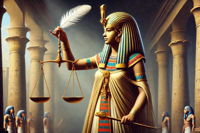
Meet the Egyptian Deities Trivia Quiz
The Egyptian deities, a pantheon of gods and goddesses, were integral to the ancient Egyptian understanding of the universe and daily life. Match these 12 based on their appearance and objects in each scene. (Click the images for a closer look!)
by trident.
Estimated time: 3 mins.











